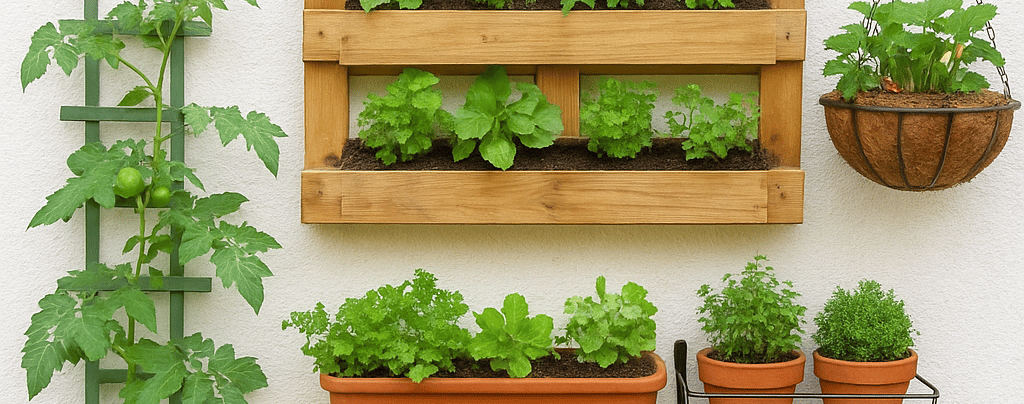🌿 GROWPlantWell – Nurture Nature, Transform Your Space 🌿
🌿 Vertical & Small-Space Gardening: Grow More in Less Space
Learn how to transform tiny gardens, balconies, and patios into lush green oases with vertical gardening ideas, tips, and plant suggestions perfect for Australian climates.
Grow Plant Well
8/13/20252 min read


🌱 Introduction
If you’ve ever wished you could have a lush garden but don’t have a big backyard, vertical and small-space gardening is your answer. Whether you live in an apartment, townhouse, or have a petite yard, you can still grow vegetables, herbs, and flowers—just by thinking upwards instead of outwards.
In this guide, we’ll explore practical ways to garden in tight spaces, the best plants for vertical gardens in Australia, and simple DIY ideas to get you started.
🏡 Why Vertical & Small-Space Gardening Works
Vertical gardening makes use of walls, fences, trellises, shelves, and hanging structures to grow plants vertically. This approach:
Maximises space – perfect for balconies, patios, and courtyards.
Improves plant health – better airflow reduces pests and disease.
Adds beauty – turns bland walls into green, living art.
Makes gardening easier – less bending and kneeling.
🛠 Creative Vertical Gardening Ideas
Trellises & Climbers – Train plants upward on frames. Best for: tomatoes, beans, cucumbers.
Hanging Baskets – Suspend planters from ceilings or beams. Best for: strawberries, trailing flowers.
Wall Planters – Modular pots or pockets attached to walls. Best for: herbs, lettuce.
Pallet Gardens – Upcycle wooden pallets into tiered planters. Best for: mixed herbs & flowers.
Tiered Shelving – Layer pots vertically on stands. Best for: succulents, compact veggies.
Gutter Gardens – Fix old gutters horizontally along a wall. Best for: leafy greens, herbs.
🌿 Best Plants for Vertical Gardens in Australia
Herbs: Basil, parsley, mint, thyme, chives
Vegetables: Cherry tomatoes, capsicum, chillies, beans, cucumbers
Flowers: Petunias, nasturtiums, pansies, lobelia
Fruit: Strawberries, dwarf blueberries, passionfruit (with strong support)
💡 Tip: Choose plants with compact growth habits or trailing vines to get the most from limited space.
🌞 Vertical Gardening Tips for Aussie Climates
Match sunlight to plant needs – most herbs and veggies need 6+ hours of sunlight.
Use quality potting mix – light, nutrient-rich, and well-draining.
Water wisely – vertical setups dry out faster; consider drip irrigation.
Feed regularly – potted plants need more frequent fertilising.
Protect from wind – higher structures can expose plants to wind damage.
♻️ DIY Pallet Vertical Garden (Easy Project)
Find a clean, untreated wooden pallet.
Sand rough edges and attach landscaping fabric to the back and sides.
Fill with potting mix and tuck in your plants.
Stand upright and water well.
🌸 Final Thoughts
Vertical & small-space gardening proves that you don’t need a big backyard to grow big dreams. With the right setup, you can harvest fresh herbs, vegetables, and flowers right outside your window—or even inside your home.
Start small, experiment, and watch your garden grow… upwards!
❓ FAQ – Vertical & Small-Space Gardening
Q: Can vertical gardens grow indoors?
A: Yes! Choose bright, sunny windows or use grow lights for herbs and small houseplants.
Q: How do I stop soil from falling out of wall planters?
A: Use a sturdy liner or landscape fabric, and pack plants snugly to hold soil in place.
Q: Do vertical gardens need more water?
A: Often yes, because gravity pulls moisture down—so check soil more often and water accordingly.
Q: Can I grow root vegetables vertically?
A: Root vegetables like carrots and radishes need depth, so use deep containers in your vertical setup.
Q: What is the cheapest way to start a vertical garden?
A: Upcycle pallets, gutters, or shelves you already own—just ensure they have good drainage and are safe for plants.
Q: Are vertical gardens high-maintenance?
A: Not necessarily. Once set up, they need similar care to potted plants: watering, feeding, and occasional pruning.
Q: Can I use vertical gardening for privacy?
A: Absolutely! Growing climbing plants like jasmine, wisteria, or passionfruit can double as a green privacy screen.
Q: Which plants are best for shady balconies?
A: Mint, parsley, ferns, lettuce, spinach, and begonias thrive in partial shade.